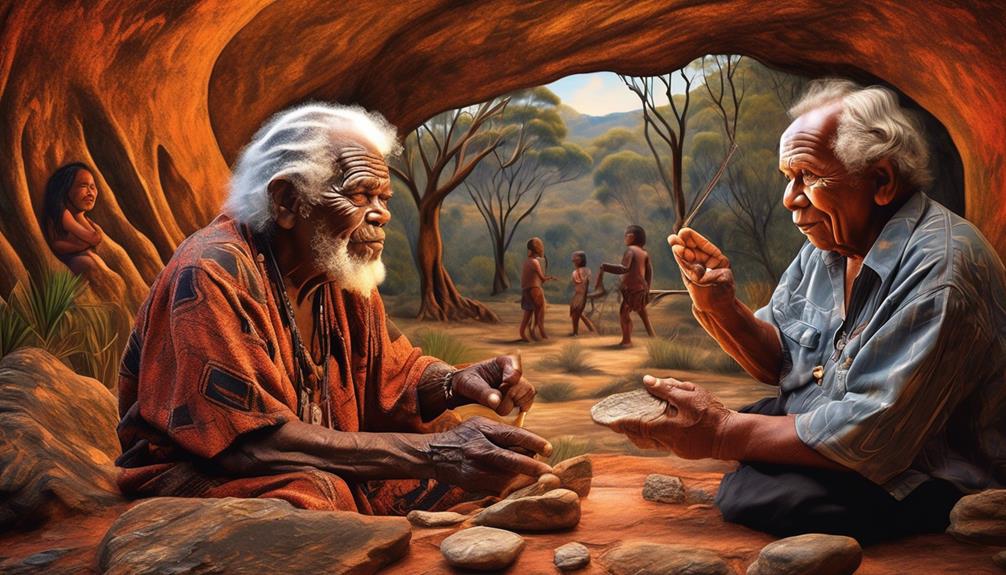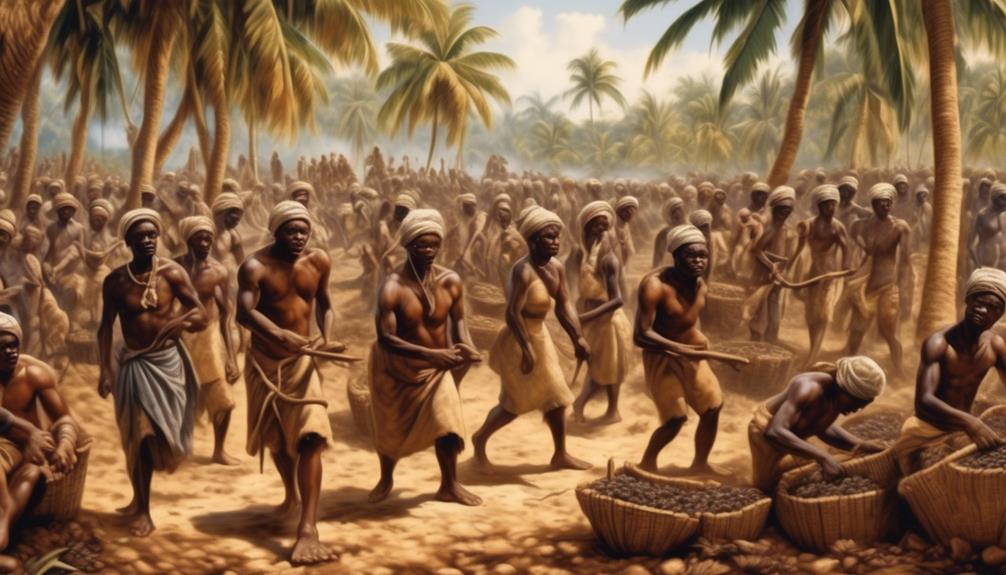What are some authentic ways to observe and celebrate Indigenous Peoples Day? This question prompts us to consider meaningful ways to acknowledge and respect the rich heritage and traditions of Indigenous communities.
There are numerous ways to genuinely engage with this important day, and understanding the significance of it is just the beginning.
By exploring the ways in which we can support and uplift Indigenous voices, we can take steps towards creating a more inclusive and equitable society.
Key Takeaways
- Attend cultural events such as powwows, storytelling sessions, or traditional ceremonies.
- Support Indigenous artists by purchasing Indigenous art, crafts, and literature.
- Learn Indigenous languages through classes or language learning apps.
- Connect with Indigenous communities and learn from their experiences.
Understanding the Significance
As we celebrate Indigenous Peoples Day, it's important to understand the profound significance of this observance in honoring the rich cultures, histories, and contributions of Indigenous peoples. Recognizing contributions from Indigenous communities is essential in acknowledging their vital role in shaping our world. Their deep connections to the land, preservation of traditions, and sustainable practices offer valuable insights into living harmoniously with the environment.
Preserving traditions within Indigenous communities is crucial for maintaining cultural diversity and heritage. These traditions encompass a wide array of knowledge, including traditional ecological knowledge, medicinal practices, storytelling, and artistic expressions that have endured for generations. By recognizing and celebrating these traditions, we not only honor Indigenous peoples but also enrich our collective understanding of humanity's vast cultural tapestry.
Understanding the significance of Indigenous Peoples Day goes beyond a mere observance; it's an opportunity to foster respect, reciprocity, and appreciation for the enduring legacies of Indigenous communities. By recognizing their contributions and preserving traditions, we uphold the interconnectedness of all cultures and pave the way for a more inclusive and equitable future.
Honoring Indigenous History and Culture

Honoring Indigenous history and culture embodies our commitment to recognizing the profound impact and enduring legacy of Indigenous peoples on our world. Understanding traditions and recognizing contributions are essential in this endeavor. Indigenous cultures have rich and diverse traditions that have shaped art, music, language, and spirituality. To honor and celebrate this, we can engage in various activities that promote understanding and appreciation of Indigenous history and culture.
| Activity | Description | Impact |
|---|---|---|
| Attend cultural events | Participate in Indigenous cultural events, such as powwows, storytelling sessions, or traditional ceremonies | Gain a deeper understanding of Indigenous traditions and foster cultural appreciation. |
| Support Indigenous artists | Purchase Indigenous art, crafts, and literature | Contribute to the preservation of Indigenous culture and support Indigenous creators. |
| Learn Indigenous languages | Take language classes or use language learning apps | Revitalize endangered languages and honor the linguistic heritage of Indigenous communities. |
Participating in Community Events
Exploring Indigenous culture through community events allows us to engage firsthand with the traditions and customs that have shaped and continue to enrich our society. Community gatherings offer the opportunity to participate in and witness traditional practices, fostering a deeper understanding and appreciation of Indigenous heritage.
Attending events such as powwows, storytelling sessions, or cultural festivals provides a space for us to connect with Indigenous communities, learn from their experiences, and celebrate their resilience and contributions.
Engaging in these community events allows us to show our support and solidarity with Indigenous peoples, acknowledging their ongoing presence and significance. It's a chance to listen to their stories, share in their cultural expressions, and honor their diverse traditions. By actively participating in these gatherings, we demonstrate our commitment to learning, respecting, and preserving Indigenous heritage.
Additionally, these events often serve as platforms for Indigenous artisans, performers, and knowledge keepers to showcase their talents and share their wisdom, fostering a sense of unity and mutual appreciation among attendees.
Participating in community events not only enriches our own cultural awareness but also contributes to the preservation and promotion of Indigenous traditions for generations to come.
Supporting Indigenous-Owned Businesses

Supporting Indigenous-owned businesses is an essential way to contribute to the economic empowerment and sustainability of Indigenous communities. By promoting economic growth and cultural preservation, we can play a pivotal role in uplifting Indigenous entrepreneurs and preserving traditional practices.
Here are a few impactful ways to support Indigenous-owned businesses:
- Patronize Indigenous-Owned Businesses: Seek out and buy products from Indigenous-owned businesses such as artisan crafts, clothing, artwork, and traditional foods. By doing so, we can directly contribute to the economic well-being of Indigenous communities.
- Spread the Word: Use social media and word of mouth to share information about Indigenous-owned businesses. Amplifying their visibility can attract more customers and help these businesses thrive.
- Collaborate and Partner: Explore opportunities to collaborate with Indigenous-owned businesses for events, projects, or initiatives. This can foster a mutually beneficial relationship and further promote economic growth within Indigenous communities.
Supporting Indigenous-owned businesses isn't just about commerce; it's about creating sustainable pathways for economic independence while honoring and preserving Indigenous cultures.
Amplifying Indigenous Voices
As we champion the economic empowerment of Indigenous communities through supporting their businesses, it's crucial to also amplify Indigenous voices, ensuring their perspectives and experiences are heard and valued.
Elevating traditions and showcasing artistry are essential components of this amplification. Indigenous voices carry wisdom, knowledge, and cultural significance that enrich our understanding of the world. By actively seeking out and listening to Indigenous voices, we honor their heritage and contribute to a more inclusive society.
One way to amplify Indigenous voices is to actively promote and support Indigenous artists, writers, and performers. Their creative expressions often mirror centuries-old traditions, offering profound insights into Indigenous cultures. Additionally, providing platforms for Indigenous leaders and community members to share their stories and perspectives can help bridge cultural divides and foster meaningful connections.
It's also vital to acknowledge the historical injustices and ongoing challenges faced by Indigenous communities, as this recognition is fundamental to effectively amplifying their voices.
In amplifying Indigenous voices, we not only recognize the richness of Indigenous cultures but also contribute to a more equitable and harmonious society.
Frequently Asked Questions
What Are Some Ways to Incorporate Indigenous Traditions and Practices Into Personal Celebrations of Indigenous Peoples Day?
Incorporating traditions and cultural practices into personal celebrations of Indigenous Peoples Day can be done through various means.
We can honor indigenous communities by learning about their history, supporting indigenous businesses, and attending events that highlight their culture.
Participating in traditional ceremonies, cooking indigenous dishes, or engaging in activities that promote indigenous art and music are also great ways to celebrate and show respect for indigenous peoples.
How Can Non-Indigenous Individuals Respectfully Engage With Indigenous History and Culture on This Day?
We can respectfully engage with indigenous history and culture by actively listening to indigenous voices, learning about their traditions, and acknowledging their ongoing struggles.
Cultural appreciation involves honoring their heritage, supporting indigenous-led initiatives, and amplifying their narratives.
It's crucial to approach this day with humility and openness, recognizing the inherent value of indigenous knowledge and experiences.
Are There Any Specific Protocols or Guidelines to Follow When Attending Indigenous Community Events on Indigenous Peoples Day?
When attending indigenous community events on Indigenous Peoples Day, it's important to honor and respect traditions. This includes engaging in cultural activities with an open heart and mind.
It's crucial to follow any protocols or guidelines set by the community hosting the event, and to approach the day with a spirit of learning and understanding.
Respecting traditions and engaging with the culture in a respectful manner is key to a meaningful experience.
What Are Some Practical Ways to Support Indigenous-Owned Businesses Beyond Just Making a Purchase on Indigenous Peoples Day?
Supporting communities and cultural appreciation go beyond just making a purchase on Indigenous Peoples Day.
Did you know that Indigenous businesses are the fastest-growing sector in Canada, with over 50,000 Indigenous-owned businesses?
To further support these entrepreneurs, we can promote their products and services on social media, attend their events, and engage in cultural exchange programs.
This fosters a deeper connection and understanding of their traditions and heritage.
How Can Individuals Continue to Amplify Indigenous Voices and Perspectives Beyond Indigenous Peoples Day?
We can continue to amplify indigenous voices and perspectives by actively seeking out and supporting indigenous artists and their work.
Elevating indigenous literature through reading and sharing their stories is another impactful way to honor and uplift their voices.
By actively engaging with and promoting indigenous creativity and narratives, we can contribute to a more inclusive and diverse cultural landscape.
These actions demonstrate our commitment to ongoing support for indigenous communities.
Conclusion
As we come together to celebrate Indigenous Peoples Day, let's remember the adage 'we are all connected.'
It's important to honor and uplift the history, culture, and voices of Indigenous peoples.
By participating in community events, supporting Indigenous-owned businesses, and amplifying their voices, we can show our respect and appreciation.
Let's continue to educate ourselves and others about the significance of this day, and work towards creating a more inclusive and equitable society for all.
Mary is a passionate writer who brings creativity and a fresh perspective to our team. Her words have the power to captivate and inspire, making her an essential contributor to our content. Mary’s commitment to storytelling and dedication to promoting Indigenous culture ensures that her work touches the hearts of our readers. We’re fortunate to have her as part of our team.










